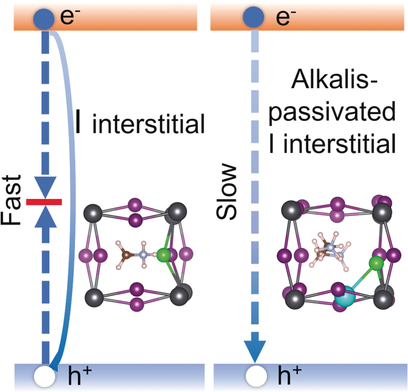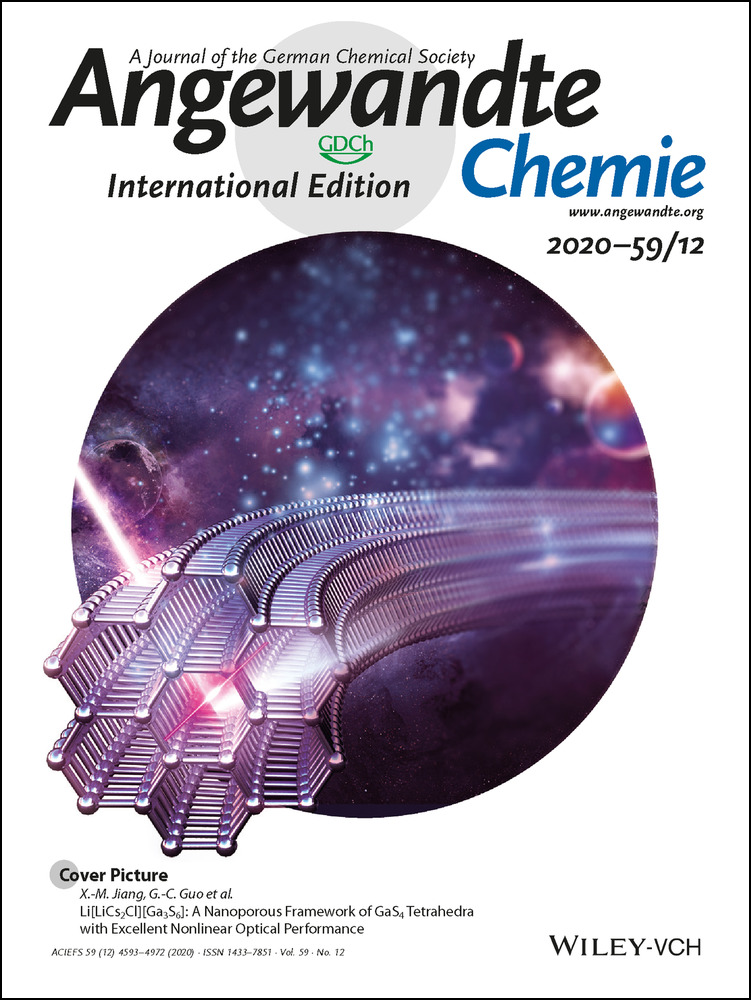Extending Carrier Lifetimes in Lead Halide Perovskites with Alkali Metals by Passivating and Eliminating Halide Interstitial Defects
Lu Qiao
College of Chemistry, Key Laboratory of Theoretical & Computational Photochemistry of Ministry of Education, Beijing Normal University, Beijing, 100875 P. R. China
Search for more papers by this authorProf. Wei-Hai Fang
College of Chemistry, Key Laboratory of Theoretical & Computational Photochemistry of Ministry of Education, Beijing Normal University, Beijing, 100875 P. R. China
Search for more papers by this authorCorresponding Author
Prof. Run Long
College of Chemistry, Key Laboratory of Theoretical & Computational Photochemistry of Ministry of Education, Beijing Normal University, Beijing, 100875 P. R. China
Search for more papers by this authorProf. Oleg V. Prezhdo
Department of Chemistry, University of Southern California, Los Angeles, CA, 90089 USA
Search for more papers by this authorLu Qiao
College of Chemistry, Key Laboratory of Theoretical & Computational Photochemistry of Ministry of Education, Beijing Normal University, Beijing, 100875 P. R. China
Search for more papers by this authorProf. Wei-Hai Fang
College of Chemistry, Key Laboratory of Theoretical & Computational Photochemistry of Ministry of Education, Beijing Normal University, Beijing, 100875 P. R. China
Search for more papers by this authorCorresponding Author
Prof. Run Long
College of Chemistry, Key Laboratory of Theoretical & Computational Photochemistry of Ministry of Education, Beijing Normal University, Beijing, 100875 P. R. China
Search for more papers by this authorProf. Oleg V. Prezhdo
Department of Chemistry, University of Southern California, Los Angeles, CA, 90089 USA
Search for more papers by this authorGraphical Abstract
Abstract
Defects, such as halide interstitials, act as charge recombination centers, induce degradation of halide perovskites, and create major obstacles to applications of these materials. Alkali metal dopants greatly improve perovskite performance. Using ab initio nonadiabatic molecular dynamics, it is demonstrated that alkalis bring favorable effects. The formation energy of halide interstitials increases by up to a factor of four in the presence of alkali dopants, and therefore, defect concentration decreases. When defects are present, alkali metals strongly bind to them. Halide interstitials introduce mid-gap states that rapidly trap charge carriers. Alkalis eliminate the trap states, helping to maintain high current density. Further to charge trapping, the interstitials accelerate charge recombination. By passivating the interstitials, alkalis make carrier lifetimes up to seven times longer than in defect-free perovskites and up to thirty times longer than in defective perovskites.
Conflict of interest
The authors declare no conflict of interest.
Supporting Information
As a service to our authors and readers, this journal provides supporting information supplied by the authors. Such materials are peer reviewed and may be re-organized for online delivery, but are not copy-edited or typeset. Technical support issues arising from supporting information (other than missing files) should be addressed to the authors.
| Filename | Description |
|---|---|
| anie201911615-sup-0001-misc_information.pdf1.5 MB | Supplementary |
Please note: The publisher is not responsible for the content or functionality of any supporting information supplied by the authors. Any queries (other than missing content) should be directed to the corresponding author for the article.
References
- 1D. Shi, V. Adinolfi, R. Comin, M. Yuan, E. Alarousu, A. Buin, Y. Chen, S. Hoogland, A. Rothenberger, K. Katsiev, Y. Losovyj, X. Zhang, P. A. Dowben, O. F. Mohammed, E. H. Sargent, O. M. Bakr, Science 2015, 347, 519–522.
- 2A. Miyata, A. Mitioglu, P. Plochocka, O. Portugall, J. T.-W. Wang, S. D. Stranks, H. J. Snaith, R. J. Nicholas, Nat. Phys. 2015, 11, 582-U594.
- 3W. S. Yang, J. H. Noh, N. J. Jeon, Y. C. Kim, S. Ryu, J. Seo, S. I. Seok, Science 2015, 348, 1234–1237.
- 4M. Aamir, M. D. Khan, M. Sher, S. V. Bhosale, M. A. Malik, J. Akhtar, N. Revaprasadu, Eur. J. Inorg. Chem. 2017, 3755–3760.
- 5T. Guner, M. M. Demir, Phys. Status Solidi A 2018, 215, 1800120.
- 6Y.-S. Chen, J. S. Manser, P. V. Kamat, J. Am. Chem. Soc. 2015, 137, 974–981.
- 7D. Ramirez, K. Schutt, Z. Wang, A. J. Pearson, E. Ruggeri, H. J. Snaith, S. D. Stranks, F. Jaramillo, ACS Energy Lett. 2018, 3, 2246–2251.
- 8A. Kojima, K. Teshima, Y. Shirai, T. Miyasaka, J. Am. Chem. Soc. 2009, 131, 6050–6051.
- 9N.R.E.L. (NREL), accessed on August 5, 2019.
- 10W. Shockley, H. J. Queisser, J. Appl. Phys. 1961, 32, 510–519.
- 11B. Chen, P. N. Rudd, S. Yang, Y. Yuan, J. Huang, Chem. Soc. Rev. 2019, 48, 3842–3867.
- 12D. Meggiolaro, S. G. Motti, E. Mosconi, A. J. Barker, J. Ball, C. A. R. Perini, F. Deschler, A. Petrozza, F. De Angelis, Energy Environ. Sci. 2018, 11, 702–713.
- 13
- 13aJ. M. Ball, A. Petrozza, Nat. Energy 2016, 1, 16149;
- 13bW. Tress, N. Marinova, O. Inganas, M. K. Nazeeruddin, S. M. Zakeeruddin, M. Graetzel, Adv. Energy Mater. 2015, 5, 1400812;
- 13cK. Tvingstedt, O. Malinkiewicz, A. Baumann, C. Deibel, H. J. Snaith, V. Dyakonov, H. J. Bolink, Sci. Rep. 2014, 4, 6071;
- 13dJ. Huang, Y. Yuan, Y. Shao, Y. Yan, Nat. Rev. Mater. 2017, 2, 17042.
- 14W.-J. Yin, T. Shi, Y. Yan, Appl. Phys. Lett. 2014, 104, 063903.
- 15J. L. Minns, P. Zajdel, D. Chernyshov, W. van Beek, M. A. Green, Nat. Commun. 2017, 8, 15152.
- 16C. J. Tong, W. Geng, O. V. Prezhdo, L. M. Liu, ACS Energy Lett. 2017, 2, 1997–2004.
- 17
- 17aA. Buin, P. Pietsch, J. Xu, O. Voznyy, A. H. Ip, R. Comin, E. H. Sargent, Nano Lett. 2014, 14, 6281–6286;
- 17bD. Meggiolaro, F. De Angelis, ACS Energy Lett. 2018, 3, 2206–2222;
- 17cD. Meggiolaro, E. Mosconi, F. De Angelis, ACS Energy Lett. 2018, 3, 447–451;
- 17dW. Li, Y. Y. Sun, L. Q. Li, Z. H. Zhou, J. F. Tang, O. V. Prezhdo, J. Am. Chem. Soc. 2018, 140, 15753–15763.
- 18J. He, W.-H. Fang, R. Long, Chem. Sci. 2019, 10, 10079–10088.
- 19S. G. Motti, M. Gandini, A. J. Barker, J. M. Ball, A. R. S. Kandada, A. Petrozza, ACS Energy Lett. 2016, 1, 726–730.
- 20D. Meggiolaro, E. Mosconi, F. De Angelis, ACS Energy Lett. 2017, 2, 2794–2798.
- 21D. Bryant, N. Aristidou, S. Pont, I. Sanchez-Molina, T. Chotchunangatchaval, S. Wheeler, J. R. Durrant, S. A. Haque, Energy Environ. Sci. 2016, 9, 1655–1660.
- 22Y. Chen, N. Li, L. Wang, L. Li, Z. Xu, H. Jiao, P. Liu, C. Zhu, H. Zai, M. Sun, W. Zou, S. Zhang, G. Xing, X. Liu, J. Wang, D. Li, B. Huang, Q. Chen, H. Zhou, Nat. Commun. 2019, 10, 1112.
- 23Z. Fang, H. He, L. Gan, J. Li, Z. Ye, Adv. Sci. 2018, 5, 1800736.
- 24E. Mosconi, D. Meggiolaro, H. J. Snaith, S. D. Stranks, F. De Angelis, Energy Environ. Sci. 2016, 9, 3180–3187.
- 25M. Abdi-Jalebi, Z. Andaji-Garmaroudi, S. Cacovich, C. Stavrakas, B. Philippe, J. M. Richter, M. Alsari, E. P. Booker, E. M. Hutter, A. J. Pearson, S. Lilliu, T. J. Savenije, H. Rensmo, G. Divitini, C. Ducati, R. H. Friend, S. D. Stranks, Nature 2018, 555, 497–501.
- 26W. Zhao, Z. Yao, F. Yu, D. Yang, S. Liu, Adv. Sci. 2018, 5, 1700131.
- 27J.-P. Correa-Baena, Y. Luo, T. M. Brenner, J. Snaider, S. Sun, X. Li, M. A. Jensen, N. T. P. Hartono, L. Nienhaus, S. Wieghold, J. R. Poindexter, S. Wang, Y. S. Meng, T. Wang, B. Lai, M. V. Holt, Z. Cai, M. G. Bawendi, L. Huang, T. Buonassisi, D. P. Fenning, Science 2019, 363, 627–631.
- 28A. Marchioro, D. Friedrich, J. Moser, J. Teuscher, M. Kunst, M. Grätzel, R. V. D. Krol, T. Moehl, Nat. Photonics 2014, 8, 250–255.
- 29C. C. Stoumpos, C. D. Malliakas, M. G. Kanatzidis, Inorg. Chem. 2013, 52, 9019–9038.
- 30R. D. Shannon, Acta Crystallogr. Sect. A 1976, 32, 751–767.
- 31G. Kieslich, S. J. Sun, A. K. Cheetham, Chem. Sci. 2015, 6, 3430–3433.
- 32A. M. A. Leguy, A. R. Goni, J. M. Frost, J. Skelton, F. Brivio, X. Rodriguez-Martinez, O. J. Weber, A. Pallipurath, M. I. Alonso, M. Campoy-Quiles, M. T. Weller, J. Nelson, A. Walsh, P. R. F. Barnes, Phys. Chem. Chem. Phys. 2016, 18, 27051–27066.
- 33
- 33aC. Quarti, G. Grancini, E. Mosconi, P. Bruno, J. M. Ball, M. M. Lee, H. J. Snaith, A. Petrozza, F. De Angelis, J. Phys. Chem. Lett. 2014, 5, 279–284; .
- 33bP. Pistor, A. Ruiz, A. Cabot, V. Izquierdo-Roca, Sci. Rep. 2016, 6, 35973.
- 34
- 34aS. Mukamel, Principles of Nonlinear Optical Spectroscopy, Oxford University Press, New York, 1995;
- 34bA. V. Akimov, O. V. Prezhdo, J. Phys. Chem. Lett. 2013, 4, 3857–3864;
- 34cB. F. Habenicht, H. Karnisaka, K. Yamashita, O. V. Prezhdo, Nano Lett. 2007, 7, 3260–3265.
- 35S. V. Kilina, A. J. Neukirch, B. F. Habenicht, D. S. Kilin, O. V. Prezhdo, Phys. Rev. Lett. 2013, 110, 180404.
- 36
- 36aO. V. Prezhdo, P. J. Rossky, J. Chem. Phys. 1997, 107, 5863–5878;
- 36bO. V. Prezhdo, P. J. Rossky, Phys. Rev. Lett. 1998, 81, 5294–5297.
- 37Simulations: Geometry optimization, adiabatic MD, and NA coupling calculations are carried out with the Vienna ab initio Simulation Package (VASP):
- 37aG. Kresse, J. Furthmüller, Phys. Rev. B 1996, 54, 11169–11186. The NAMD simulations are performed by the PYthon eXtension for ab initio dynamics (PYXAID) code:
- 37bA. V. Akimov, O. V. Prezhdo, J. Chem. Theory Comput. 2013, 9, 4959;
- 37cA. V. Akimov, O. V. Prezhdo, J. Chem. Theory Comput. 2014, 10, 789. The details of the Computational Methods are described in the Supporting Information.





